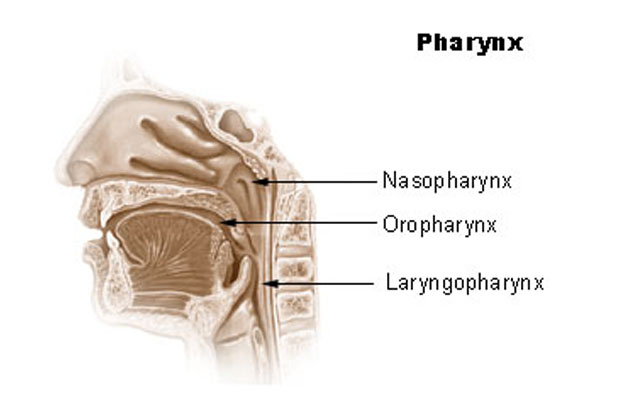
What is Pharynx?
The pharynx is situated directly after the mouth and nose and lies right before the esophagus.
Formation and Orientation
The pharynx is divided into three separate sections.
The nasopharynx is the first part of the pharynx that lies between the soft palate and the base of the skull. The pharyngeal tonsils are located on the back wall of the nasopharynx. This portion of the pharynx is connected to the middle easr by the Eustachian tubes. The nasopharynx is linked to the nasal cavities by choanae. On its outerwalls, there are triangle shaped pharyngeal ostia and the torus tubarius. There are two folds that come from this opening; the salpingopharyngeal fold and the salpingopalatine fold. The salpingopharyngeal fild contains the calpingopharyngeus muscle. The salpingopalatine fold is a small fold containing the levator veli palatine muscle and stretched from the torus to the palate.
The oropharynx also known as the mesopharynx, is from the uvula to the hyoid bone. It opens to the mouth while through the palatoglossal arch and the palatopharyngeal arch, the tonsil is introduced. The outer wall holds the bases of the tongue and the epiglottic vallecula while the opposing wall is made of the tonsil and its components, the top wallis made up of the soft palate and the uvula. The epiglottis is the part on the pharynx that separates food and air as it travels to take it to its respective tube (epiglottis or trachea).
The laryngopharynx is also known as the hypopharynx and connects the throat to the epiglottis. It is the part that introduces the epiglottis two separate pathways. The laryngopharynx continues all the way thtough the esophagus on the posterior wall. This part of the pharynx has three major parts; the pyriform sinus, postcricoid area and the posterior pharyngeal wall.
Function
The pharynx allows for food and drink holding nutritional value to begin its journey through the digestive tract by permitting it into the esophagus while also helping in respiration to deliver the air to the trachea. The pharynx also allows for an equalization of air pressure on the eardrum membrane.
Image Caption: Pharynx. Credit: Arcadian/Wikipedia












